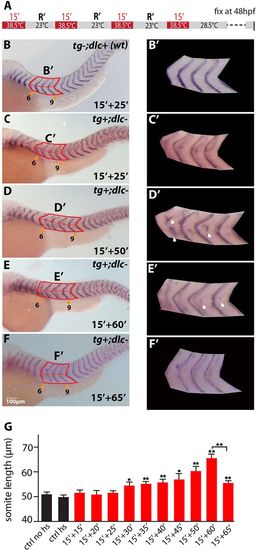Fig. 4
- ID
- ZDB-FIG-140523-40
- Publication
- Soza-Ried et al., 2014 - Pulses of Notch activation synchronise oscillating somite cells and entrain the zebrafish segmentation clock
- Other Figures
- All Figure Page
- Back to All Figure Page
|
Somite widths can be modified by varying the interval between heat-shocks. Batches of tg+;dlc embryos were taken at the 3-somite stage and heat-shocked four times as in Fig. 3, but with different recovery times, R, between one heat-shock and the next for the different batches. (A) Scheme of heat-shock treatment. (B-F) Typical results for different heat-shock repetition cycle times, from 15+15min (i.e. 15min at 38.5°C followed by 15min at 23°C) to 15+65min. (B) A control (tgdlc+) wild-type embryo heat-shocked four times on a 15+25min schedule. (C-F) tg+;dlc embryos subjected to various different heat-shock regimes as indicated. Repetitive heat-shock rescued somite boundary formation to a sufficient extent in almost every case to allow measurement of somite width. (B2-F2) Detailed views of the region measured for each batch, corresponding to the sixth to the ninth somite (red boxes in B-F). White arrowheads in D2 mark fragments of somite boundary in the middle of giant somites. (G) Histogram of mean somite width (defined as distance from the vertex of one somite-boundary chevron to the next, shown by red line in B-F) for the measured region, as a function of heat-shock repetition cycle time. Note that embryos with heat-shock repetition cycle times of 15+30min to 15+60min produce bigger somites than those observed in the non-heat shocked controls (ctrl no hs) in the evaluated region, with reversion to a size only slightly greater than control at 15+65min. *P<0.05; **P<0.005, two-tailed t-test. |
| Gene: | |
|---|---|
| Fish: | |
| Condition: | |
| Anatomical Term: | |
| Stage: | Long-pec |

